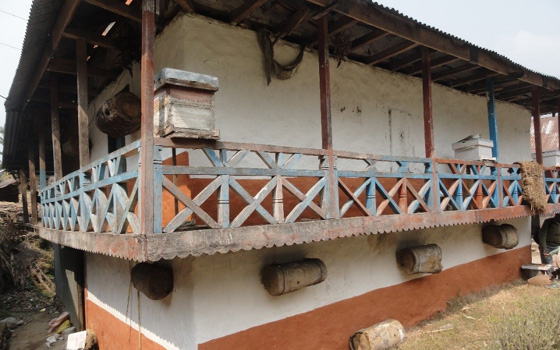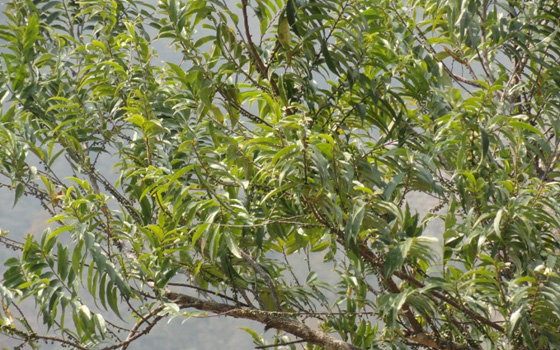This site uses cookies, as explained in our terms of use. If you consent, please close this message and continue to use this site.
 Bee colonies in log and movable frame hives in a house in Golfe village in Phurumbu. The owner of the house, Dil Kumar Dahal, has around 22 colonies in different hives.
Bee colonies in log and movable frame hives in a house in Golfe village in Phurumbu. The owner of the house, Dil Kumar Dahal, has around 22 colonies in different hives.
Beekeeping is a common practice among pilot households in the Support to Rural Livelihoods and Climate change Adaptation in the Himalaya (Himalica) initiative in Taplejung, Nepal. Farmers usually keep Apis cerana bees in traditional fixed comb log hives. The area is rich in flora necessary for honeybees to survive and produce honey. Leucosceptrum canum (known as bhusure in Nepali), Eurya accuminata (wild osmanthus), Brassica juncea (mustard), and Prunus cerasoides (wild cherry) are the main sources of nectar, depending on what time of the year it is. These flowering plants form the basis of the development of beekeeping enterprises. Other bee forage sources available include Berberis spp., Castanopsis spp., Eupatorium spp., Pyrus pashia, Rubus ellipticus, Saurauria nepalensis, Schema wallichi, and Zea mays.
In addition to supporting farmers adopt resilient production practices in large cardamom production, the Himalica programme of the International Centre for Integrated Mountain Development (ICIMOD) is also promoting beekeeping as an income diversification option. By introducing modern methods and practices to beekeeping management, and building the capacities of partners, farmers, and local youth, the programme hopes to help enhance the resilience of the region’s mountain people. In April 2016, ICIMOD, in partnership with the Environmental Conservation and Development Forum (ECDF), trained 25 farmers – a majority of the participants were enthusiastic youth and women from different pilot villages – in modern beekeeping, honey harvesting and processing methods, and the use of honeybees as pollination service providers. The training was organized to help develop a pool of model beekeeping entrepreneurs and local resource persons to encourage and support other farmers in the villages.

Eurya accuminata, locally called jhigane, is a major source of nectar for honey produced between September and October in Taplejung.
ICIMOD’s consultant apiculturist AN Shukla and I, along with the director, programme officer, and field staff of ECDF, visited the homes of the participants of last year’s training recently. The visit was organized to see if the farmers were using the bee management methods they learnt during the training, to record their experiences doing so in cases where the methods were being applied, and to provide technical support where needed. We were overwhelmed to find that the training has started to show impact. Most farmers have at least two colonies each in movable frame hives. We were also happy to see that beekeeping has already started making a good contribution to the household incomes of many of the farmers we visited. This will increase as the farmers gain further confidence in managing colonies using modern methods.
Here are a few stories from the field:
Dil Kumar Dahal of Golfe village in Phurumbu was one of the trainees who took a keen interest in learning modern beekeeping management methods. He has 22 beehives, most of which are in log hives. After the training, he adopted moveable frame hives and currently has six colonies in his modern hives. He says the training has helped him a lot.

Dil Kumar Dahal with his little daughter. A log hive is visible in the background. He is holding a small block of beeswax which he processed using the methods he learnt during his training.
It is very easy to manage bees and harvest honey from movable frame hives, he says. He plans to increase his colonies to 50 and wants to put them all in moveable frame hives. He currently harvests 80 kg of honey per year. He sells the honey at NPR 1,200 per kilo. Beekeeping brings him NPR 6,000 per year. Dil Kumar says he has no problem selling honey. In fact, the demand for Taplejung honey exceeds production. Most of the buyers are from Jhapa, where he has good contacts. He also sells honey to Nepalis who live abroad. Dil Kumar has learnt beeswax processing as well.
Another trainee, Chandra Bahadur Karki of Phurumbu-5, has about 15 log hives for bee colonies. He has put two colonies in movable frame hives, one of which had a wax-moth problem. He produces about 50 kg of honey per year and sells it at the rate of NPR 1,000 per kg to locals. He has no problem selling honey. Like Dil Kumar, Chandra also dreams of increase his colonies to 50 by capturing bee swarms with new colonies in moveable frame hives.
Khadga Prasad Dahal of Osay village in Sikaicha-8 has transferred two bee colonies to movable frame hives. He has 12 colonies in log hives. Khadga says, “It is very easy to manage bees in modern hives. And we get more honey from these hives”. He has already harvested honey twice after transferring the colonies to movable frame hives. He harvested five kg of honey from each hive both times. “I have had bees in log hives for many years but I never saw beekeeping as an income source.

An Shukla (centre), a beekeeping expert, inspecting Chandra B Karki’s (left) colony.
I had never sold a bee colony or even a kilo of honey before this. This year I sold six colonies at the rate of NPR 6,000 per colony, and earned NPR 36,000. I also sold some honey. I sent honey to my daughters and other relatives in Kathmandu”. Khadka captures swarms and hives them to start new colonies. He plans on increasing the number of bee colonies he has in movable frame hives to 25. He also helps others in the village hive bee swarms and manage their colonies.
The training not only succeeded in encouraging farmers to adopt modern bee management methods and equipment but also created demand for modern beehives. As a result, the bee hive making business of Purna Hang and Kul Bahadur Limbu of Phurumbu has also expanded. Purna Hang has established his hive-making workshop in Taplejung to better access the required voltage supply for making beehives and other furniture. He sells beehives for NPR 3,000 per hive. He sold beehives worth NPR 50,000 last year, and has sufficient orders to earn NPR 150,000 or more this year. Purna and Kul Bahadur are not only selling beehives but also bee colonies and honey.
These are only some of the ‘success stories’ coming out of Himalica pilot sites in Taplejung where beekeeping was promoted as an income generating option. Farmers – those who participated in the training, and their neighbours – have started to realize the benefits of using improved equipment and bee management techniques to increase honey production and quality, and thereby income. Many are also encouraged to take up beekeeping as an income generating enterprise.

Purna hang showing his beehive.
In addition to just providing technical support, we also encouraged the demo farmers involved in the programme to use honeybees to pollinate their large cardamom crops. Five farmers in Phurumbu, Sikaicha, and Teen Ghare in Taplejung Municipality have been selected to demonstrate the impact of pollination on large cardamom yields and the quality of capsules, and record the results to make a case for informing concerned institutions for making appropriate policies/plans to promote bees for their pollination services to improve crop yield and quality.
Stay up to date on what’s happening around the HKH with our most recent publications and find out how you can help by subscribing to our mailing list.
Sign Up